
SHUTTER





SHUTTER



We’ve rebranded, but we’ve never left. We’re still here for you. The down to earth financial team you’ve come to know over the years, now as Wilkerson Advisory Group.
Still orchestrating your financial life, from investment strategies to tax planning to personalized wealth transfer solutions—all custom-tailored around your life and your goals.


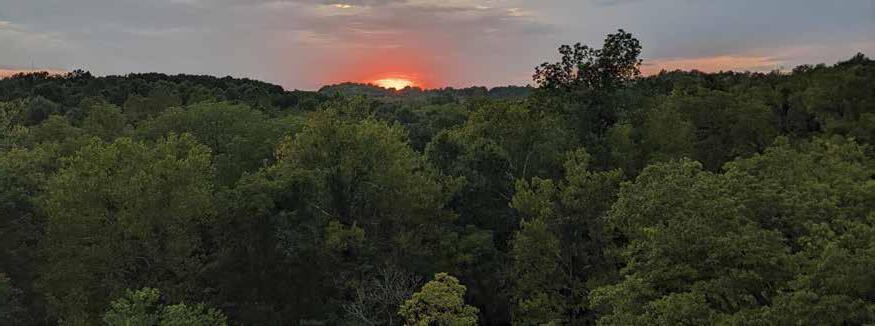


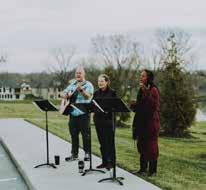
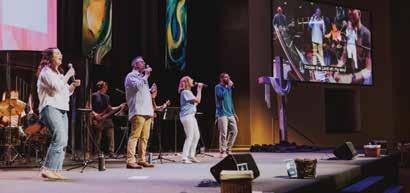

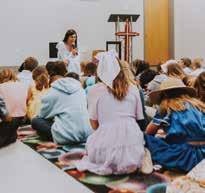









Are you taking full advantage of your lifetime estate and gift tax exemption?
Commerce Trust, working in conjunction with your estate planning attorney, can guide you through the in-depth conversations required to assess how the use of tax exemptions could most effectively be incorporated into your estate plan.
The holistic, team-based approach at Commerce Trust, consisting of financial and tax planning, investment portfolio management, and trust administration, is designed to guide you toward achieving your family’s goals while safeguarding your legacy.
Connect with Lyle Johnson, your dedicated Market Executive for Commerce Trust, at (573) 886-5324 or lyle.johnson@commercebank.com.
Learn more about securing your legacy at commercetrustcompany.com/estatetax.
PUBLISHING
David Nivens, Publisher david@comocompanies.com
Chris Harrison, Associate Publisher chris@comocompanies.com
EDITORIAL
Jodie Jackson Jr, Editor jodie@comocompanies.com
Kelsey Winkeljohn, Associate Editor kelsey@comocompanies.com
Karen Pasley, Contributing Copyeditor
DESIGN
Jordan Watts, Senior Designer jordan@comocompanies.com
MARKETING
Charles Bruce, Director of Client Relations charles@comocompanies.com
Kerrie Bloss, Account Executive kerrie@comocompanies.com
CONTRIBUTING PHOTOGRAPHERS
Lana Eklund, Jodie Jackson Jr, Elizabeth Jordheim, Marci Mertens, Doug Miller, Dani Mondloch, Nikki Reese, Kelsey Winkeljohn
CONTRIBUTING WRITERS
Casey Barwick, Sunitha Bosecker, Beth Bramstedt, Jodie Jackson Jr, Brandon Knight, Hoss Koetting, Madeleine Leroux, Natasha Myrick, McKenna Stumph, Kelsey Winkeljohn
SUBSCRIPTIONS
Magazines are $5.95 an issue. Subscription rate is $54 for 12 issues for one year or $89 for 24 issues for two years. Subscribe at comomag.com or by phone. COMO Magazine is published monthly by e COMO Companies.
OUR MISSION STATEMENT
COMO Magazine and comomag.com strive to inspire, educate, and entertain the citizens of Columbia with quality, relevant content that re ects Columbia’s business environment,
In my head, there’s an associative imagery that accompanies the phrase “Art & Culture.” I picture it as this giant, owy watercolor sensation — vivid, uid, and di cult to contain. “Art” feels more concrete, bringing to mind murals, statues, and tangible expressions. “Culture,” on the other hand, is abstract and all-encompassing, like the air around it.
e two are inseparable, really. roughout history, art has emerged from major cultural events and shifts, while at the same time, art has the power to create its own cultures and subcultures. It’s a beautiful, endless loop.
e cool thing about art and culture is that they permeate our lives every day, whether we’re in tune with them or not. While my daily routine tends to shift (depending on how many times I hit that snooze button), I can quickly think of several ways my mornings start with art and culture: deciding what to wear, the music or audiobook I listen to on my drive to work, the meals I make for breakfast, the billboards and bumper stickers I pass. ese seemingly small details shape how we think and view the world, and no matter where we go, they’re right there, following us, inspiring us, and sneaking into the corners of our day.
As a college town, Columbia is no stranger to art and culture, and both the colleges and the community do an excellent job amplifying these elements. One of my earliest memories from my freshman year at Columbia College is participating in the Cougar Day Trip during Welcome Week. ose day-long excursions were designed to help new students make friends and get acquainted with our four-or-more-year home.
I chose to attend “Wildy’s World Mural Painting Day.” Along with a group of about twelve students, we walked down to Orr Street to meet Wildy, the studio owner. I remember feeling shy, as I was much more introverted and didn’t know anyone in my group. But those feelings quickly melted away as the paints came
out. We started working together, creating a beautiful work of art that would hang in the student commons for the rest of my time at Columbia College. We didn’t even have to talk much — the materials we shared were all the language we needed.

While those Day Trips zzled out during COVID (and I’m not sure if they ever made a comeback), Columbia College remained committed to fostering art and culture in a number of ways. One of my favorite activities was International Co ee Hour. Each month, students from di erent countries hosted, o ering a variation of their nation’s co ee, snacks, and entertainment from their culture — sometimes music, sometimes activities like writing attendees’ names in the hosts’ native language, or doing cultural crafts. It was not only a great way to meet students, but also to give international students a forum to share their culture with everyone else. I imagine it was a chance to give them a little slice of home and comfort in Columbia.
Even though I’m no longer a student, I continue learning from the art and culture in our city, of which there’s no shortage. Just look at e Shops at Sharp End and the Boone County History & Culture Center, preserving our local histories. Or the Columbia Art League, Ragtag Cinema, e Blue Note, and more. It’s all around us, every day. Whether you’re a temporary resident — student or not — or a long-term local, it’s worth getting out there and exploring, even when you think you’ve done it all.
Because, trust me, you haven’t.


KELSEY WINKELJOHN ASSOCIATE EDITOR kelsey@comocompanies.com
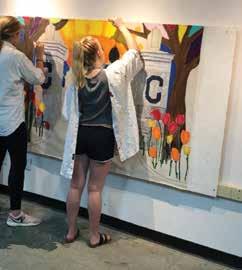
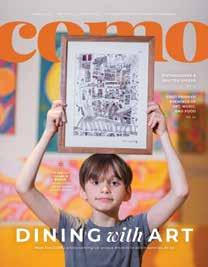
We take pride in representing our community well, and we couldn’t do what we do without our COMO Magazine advisory board. Thank You!






Beth Bramstedt
Church Life Pastor, Christian Fellowship Church

Heather Brown
Strategic Partnership Officer, Harry S Truman VA Hospital

Emily Dunlap Burnham
Principal Investigator and Owner, Missouri Investigative Group

Tootie Burns
Artist and Treasurer, North Village Art District

Chris Horn
Principal Treaty
Reinsurance Underwriter, American Family Insurance

Kris Husted
Investigative Editor, NPR Midwest Newsroom

Laura Schemel
Director of Marketing and Communications, MU Health Care
Art Smith
Author & Musician, Almost Retired
Megan Steen
Chief Operating Officer, Central Region, Burrell Behavioral Health
Nathan Todd
Business Services Officer, First State Community Bank
Casey Twidwell
Community Engagement Manager, Heart of Missouri CASA
Wende Wagner
Development Manager, DeafLEAD
Have a story idea, feedback, or a general inquiry? Email Jodie@comocompanies.com.
HIS DREAMS ARE INFINITE. WHICH IS WHY OURS ARE, TOO.

Every patient has hopes and dreams. Our dreams are to help make theirs come true. That means we never compromise in our pursuit of breakthrough medicine. And we never settle when it comes to your health. Neither should you.
NEVER SETTLE



Experience the Ozarks after dark at Top of the Rock’s Nature at Night, now available through spring! Drive your own private golf cart through a 2.5-mile trail featuring stunning light displays, waterfalls, bridge crossings, and a marvelous cave and Bat Bar! Become illuminated with inspiration to conserve our natural world today and forever on this one-of-a-kind spring tour!
advanced tickets recommended : topoftherock . com
@ topoftherockmo

Vidwest creates affordable path for learning the film industry.
BY BRANDON KNIGHT
You once had to be wealthy, move to Los Angeles, or know somebody in the industry to become involved in lmmaking. Now, in Columbia, you just need a membership to Vidwest Studios — and an eagerness to learn.
Vidwest was founded in 2019 in the space formerly occupied by Federated Auto Parts. Since that time, Vidwest has become a mecca for local digital artists to gather and connect. With access to studios, cameras, digital archiving, and now even a large printer, individuals can begin their journey down the path of creation.
Would-be lmmakers have two options: either go to a lm school or go the freelance route. Unfortunately, the lmmaking industry as a whole still requires a degree to gain employment. However, many independent lmmakers can start their own freelance business with no degree at all.
Until now, the common path for an individual looking to get into lmmaking was lm school. However, lm school is often a costly endeavor. Currently, the cost of attendance at Mizzou for a Missouri resident is $33,038 per year. at comes to $132,152 for a four-year bachelor’s degree. at nancial reality makes the goal of becoming a professional lmmaker a lofty pursuit. rough Vidwest, students looking to get into the eld can gain hands-on knowledge through several programs or by simply trying out gear and learning on their own. By booking a training session through its website, Vidwest can teach the necessary skills to get started.
“Vidwest is where you go when you don’t have 325 grand to spend on equipment,” said Dustin Hawkins, a local indie lm maker and member of Vidwest.
Some individuals may not want to go the traditional route of lm school and may want to make lms for fun or as a freelancer. Vidwest provides those individuals with the same training, o ering gear rental or training sessions. at gives students the exibility to work around their schedules. Cost is often the biggest barrier to entry in lm making. e gear can often be expensive, and many individuals don’t have hundreds of dollars to spare on equipment. Vidwest aims to bridge that gap.

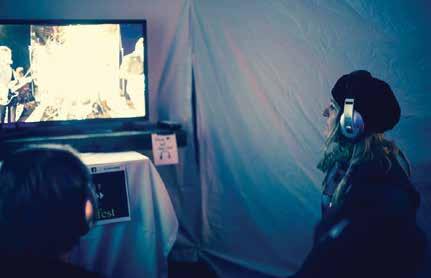
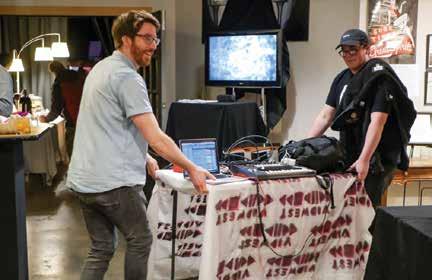
2019
VISION
To advance the art of cinematic storytelling in Missouri and to serve Columbia’s growing grassroots media community
BOARD OF DIRECTORS
• Tim Pilcher
President
• Johnathan Asher Board member, studio manager
• Trevor Harris Board member
• Brian MacNeel Board member
• Scott McGarvey Board member
TEAM MEMBERS
• Robin Anderson Development coordinator and co-founder
• Chris Kendrick Studio manager
• Matt Schacht
Studio manager and co-founder
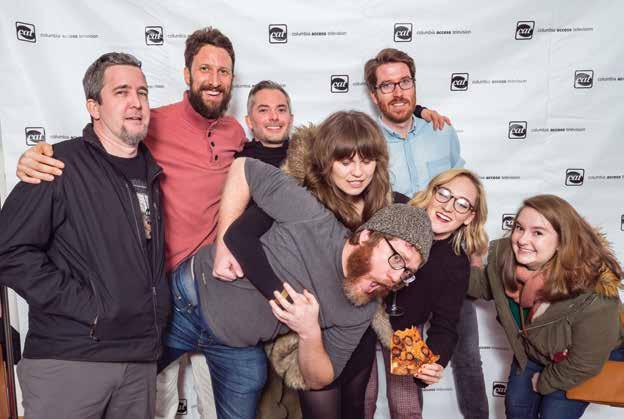
“Vidwest is similar to a public library,” said Studio Manager Jonathan Asher. “Instead of magazines, we have cameras.”
For a $75 annual fee, Vidwest provides access to its studio and gear. For members, $1 grants access to additional classes such as advanced lmmaking, audio production, and more. In 2024, eleven professional instructors hosted seventeen classes. Funding has come from the city of Columbia O ce of Cultural A airs (OCA). ose classes are set to continue through 2025 with a grant provided by OCA.
For students, seniors, and military members, the annual membership fee is $35. at amounts to roughly 42 percent of Vidwest’s total membership. For other individuals who can’t a ord the $75 annual fee, Vidwest has o ered scholarships. For 2024, 10 percent of all Vidwest members received a scholarship to help with membership fees.
“It is a place where no matter where you are nancially, you can learn how to use the tools you want to tell your stories,” Hawkins explained.
Of the 4,353 reservation requests Vidwest received in 2024, nearly 3,200 of those orders were completed. ree new part-time studio managers who were hired last year are on-call six days a week for thirteen hours a day. Volunteers also amassed a collective 2,669 hours in 2024.
Vidwest has provided hands-on training opportunities among its members. For instance, in partnership with Cafe Berlin,
members helped with livestream services to provide training to Columbia residents. Additionally, with the help of MU’s Community Engagement Learning O ce, Vidwest built an internship program.
Grants, services, and donations from 209 donors produced $95,242 in revenue in 2024, a 23 percent increase from the previous year. e nonpro t’s 2024 balance sheet also showed a 34 percent increase in expenditures to $67,316.
Most of Vidwest’s gear is donated by individuals or studio volunteers. With the membership fee, members gain access to camera gear, lighting, and sound gear. Additionally, members have access to rent parts of the studio for sound production, video production, screenings, and audio production.
“As a Vidwest member, if there is any equipment you don’t know how to use, we will train you on it,” Asher explained.
For anyone looking to get involved, the best place to start is the Vidwest website.
“ e more involved [you are] with Vidwest, the more likely [you are] to become a part of these big projects,” Hawkins said. “We can’t turn you into an artist, but we can teach you the tools for becoming a better artist.”
Vidwest Studios 1600 Business Loop 70 East Columbia, Missouri 65201 info@vidwest.org 423-742-1429




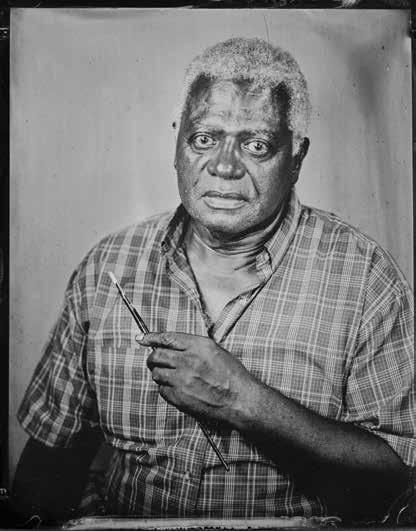
David Lancaster thrives in his Orr Street creative space.
BY CASEY BARWICK ARTWORK COURTESY OF DAVID LANCASTER
After a tumultuous family decision to move to Columbia for David Lancaster’s medical practice, he found solace in the energy and excitement of First Fridays. Lancaster, a certi ed physical medicine and rehabilitation physician who now works in medical law, has since dipped not just his toe but his entire foot into the local art scene.
Delving into his creative career, Lancaster knew he wanted his own space to work and to be around artists.
“When you’re around people of the same mindsets, you tap into this wave of creativity,” he explained. “You feed o of one another in di erent disciplines, and I really enjoy it.”
Lancaster fell in love with photo design as a teenager after his father gave him a camera to use at family gatherings. In the rising heat of his medical career, he put down his camera to pick up a stethoscope. It wasn’t until his family moved to the area fteen years later that he revisited his alternative passions. One of his goals was to become a pilot, but after ying the skies, he sold his plane club shares to purchase camera equipment.
For ten years, he has been creating behind his studio’s ornate steel door, designed by Chris Teeter in 2006. His current gallery residence, Orr Street Studios, has homed dozens of artists, some of whom Lancaster listed as his creative heroes. ose heroes include nationally renowned photographers Michael Kenna and Annie Leibovitz, and local artists Sharon Hyatt and the late Byron Smith.
Lancaster’s creative in uences drive his technical passions. Whenever he needs ideas, he reaches for photography books that showcase lighting work, model positioning, and camera techniques. After reading, he practices the techniques in di erent variations to expand his skill.
“I originally wanted to be a musician,” he said. “You learn by listening to your favorite songs and artists, learning their songs, then when you learn many people’s work, you start to build your own style.”
Lancaster’s artistry is not just a visual medium, but a personal escape. In his medical career, he is often frustrated with insurance companies, administration, and
Established in 2009, the North Village Arts District is the heart of Columbia’s art scene. It encompasses more than a dozen businesses, hundreds of local artists, several ornate sculptures and murals, and several monthly events. Located in the northern downtown area, the art district, or NVAD, has a designated art walk that guides visitors through the various artistic exhibits and locations throughout the area.
Some include Sparky, the raptor sculpture designed by Vincent Houston; the Walnut Street courtyard sculpture designed by Adrienne Luther; and the “Art Lives Here” installation between Artlandish and Sager Reeves Gallery. The art walk is a community staple for First Fridays, when all of the downtown galleries open their doors on the first Friday of each month to present exhibits and current pieces. Several local music hubs and bars also welcome visitors with rich music and performances.
Barbara Hoppe, Orr Street Studios director, has art walk ideas for newcomers.
“We hope they will feel welcomed and that they enjoy the experience, being in this unique and lovely space, seeing the art and also the one-of-a-kind sculptured doors made by Chris Teeter, as well as talking with the artists and with others there enjoying art and creativity.”
Orr Street Studios, currently showcasing its Missouri Photo Workshop Exhibit, is one of several thriving galleries within the art scene. Other galleries include Sager Reeves, which is currently showing its exhibit “The Women”; Artlandish, known for its jewelry, pottery, and fine arts; and Serendipity Salon and Gallery. Several restaurants are also a part of the experience, including Acola Coffee Company, Le Bao Asian Eatery, Wishflour Bakery, The Roof, Ernie’s Cafe, Fretboard Coffee, and 11Eleven. Together, the businesses and artists provide a rich creative atmosphere, engaging events, and community regardless of the day of the week.
Here is a list of businesses and galleries that are part of the North Village Arts District:
• Art Underground
• Artlandish Gallery
• Artworks Studios
• The Atrium
• The Beach Salon
• Cafe Berlin
• Castello Branco Fields
• Coming Home
• Curations 573
• Downtown COMO
• Frame Shop on Orr
• Fretboard Coffee
• Hempriety
• Jane Mudd
• Jenny McGee
• John Fennell
• Jonathan Asher
• Julie Youmans
• Le Bao Asian Eatery
• Leo Falkinstein Gallery
• Lisa Bartlett
• Love Columbia
• Mareck Center for Dance
• Michelle Seat Fine Art
• Monarch Jewelry
• North Village Recording
• Orr St. Farmers Market
• Orr Street Studios
• Range Free
• Rose Music Hall
• Sager Reeves Gallery
• Sara Fougere Catering
• Serendipity Salon & Gallery
• Shannon Webster
Art Studio
• Sharyn Hyatt
• Shear Soul Hair Studio
• Stop-Gap Projects
• Talking Horse Productions
• Tootie Burns Mixed Media
• Wishflour Bakery
• Yoga Sol
medical liability. ose strong emotions have driven him to design protest pieces like “Broken”, his most notable creation. “Broken” is a portrait photo story in which Lancaster asked medical sta , patients, and administrators to choose a word that described the hospital environment at the height of the COVID-19 pandemic and write the word on a piece of paper.
Some of the words included: anguish, determined, despair, numb, humanity, fatigued, blessed, and together. Once chosen by the individual, that word was theirs, and then Lancaster photographed the person holding the card. Some individuals’ stories were recorded, too, and recounted, with raw emotion and passion, their experience in health care. ose videos and photos, available on his website, are interactive and include video or audio about those experiences.
Lancaster came up with the idea behind “Broken” when eating downtown at Sycamore, where he rst encountered a QR code menu. When his art piece was complete, he listened to his subjects’ stories and felt a sense of relief from all his anger and frustrations.
“I think with all the emotions we feel,” he said, “there’s an energy to it, and part of being conscious is being able to do something either productive or destructive with it.”
Lancaster’s work extends beyond portraiture. His photography also includes architecture, statues, street photography, landscape, and tintypes. Tintypes are taken using a thin sheet of metal covered in a light-sensitive collodion chemical mixture, then exposing the plate in the camera. at results in high-contrast, black-and-white photos. Lancaster noted that he liked how this method of photography — as well as his other current medium, platinum palladium printing — is known for its longevity. e photos he takes can last for decades, or even centuries, and in his eyes, will carry his story and legacy on for generations.
He inherited more than 1,000 family photos, which he and his siblings dug through to draw their family tree. In doing so, the experience made him want to extend a photographic branch.
Family and community are of paramount importance to Lancaster. As he now works within his studio at Orr Street, he opens his door every rst Friday of the month to curious visitors. Orr Street Director Barbara Hoppe gives Lancaster high praise.
“David Lancaster is a very talented, knowledgeable, and diverse photographer, with a very keen and artistic eye, whose photographs are exceptional,” Hoppe said.
As Lancaster continues his artistry, he wants to improve his technical skills in advanced mediums, even setting up a dark room in his studio to continue his practice. rough his dedication to both art and science, his blend of creativity with technical mastery ensures his place within the community — and an extremely well-documented branch on his family tree.
“I want to put something together so that my great, great, great grandkids, who I’ve never met, will know a little bit about where they came from,” he said. “I wanted to be famous like the Beatles. People will know the Beatles or Paul McCartney for probably another 1,000 years. Beethoven and Shakespeare did these immortal things. And of course, it’s not like I’m going to be famous, but I can pass them down to my family.”
STORY AND
BY JODIE JACKSON JR
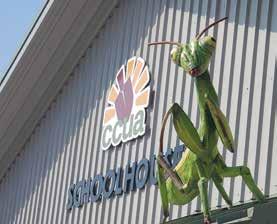
Late winter sunlight bathed the still-new insect sculptures at the Columbia Agriculture Park at Clary-Shy Park in mid-March. e metal critters were featured at a Columbia Center for Urban Agriculture (CCUA) ribbon cutting in October 2024.
One installation has three ladybugs attached to the entrance of a trellis walkway into the Agriculture Park. e other sculptures feature a praying mantis, butter y, and a bee. e new additions are the creation of Eureka Springs, Arkansas, artist Stephen R. Feilbach. Two of the sculptures were donated to the park, and two of them are on display through a ten-year agreement.
e Agriculture Park is also the location of the Columbia Farmers Market, housed by the MU Health Care Pavilion at 1769 W. Ash St. In addition to the new art, CCUA will soon begin construction of a community welcome center at the park, which will feature event space, a community kitchen, and expanded food production.

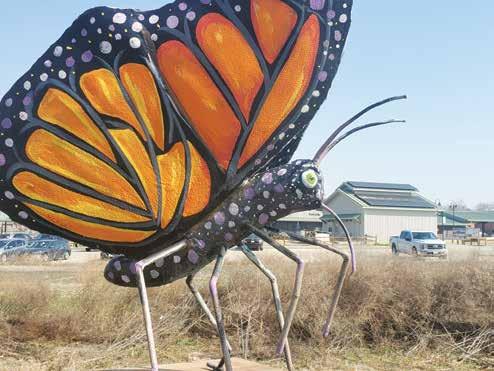
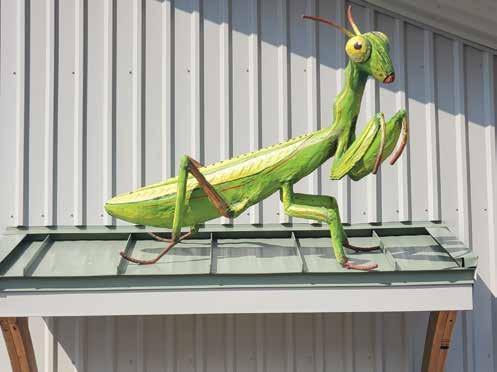





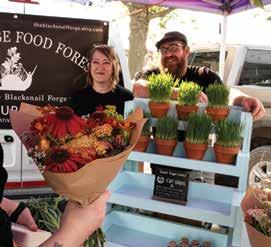



BY BETH BRAMSTEDT
Ihad not known David and Lucy for long. I met them through email when we corresponded during COVID. ey were always quick to talk about their family. ey had usually just been to visit or were about to visit. I could picture David smiling as he wrote back to me, rehearsing the memories they had made.
Although David and Lucy attended church every week online, I could not see them. So, it was only a few weeks before Lucy’s death that I was able to meet them in person. Even under the circumstances, my heart was full of joy. I did not know what to expect when I walked inside their apartment and turned the corner into Lucy’s bedroom — but what I encountered was a glow and a light that only God could have orchestrated. Lucy’s face shown with a heavenly countenance. e only word that came to mind as I looked past her frail body to her face was ... “beautiful.” She was radiant with the love and peace of God.
In that moment, even in her sickness and pain, she ministered to me. As I put my arm around her shoulder and let her lean on me, I watched as she quietly communicated to her husband of 41 years what she needed. A slight lift of her eyebrows or a hand on her tummy. And he would gaze at her lovingly and respond.
At one point Lucy wanted to walk. She attempted to stand on her own, and David stood in front of her, guiding her hands to his shoulders. As he began to walk backwards, looking into her eyes, she followed. Tears welled up in my eyes. ey were dancing. It was precious.
It was a picture to me of what heaven will be like — only then, Lucy will be able to lead David around the dance oor without reservation!

at day I was encouraged by the story of Lazarus in John 11.
When Jesus nally got there, he found Lazarus already four days dead. Martha heard Jesus was coming and went out to meet him. Mary remained in the house.
Martha said, “Master if you had been here, my brother would not have died. Even now, I know that whatever you ask God, he will give you.”
Jesus said, “Your brother will be raised up.”
Martha replied, “I know that he will be raised up in the resurrection at the end of time.”
“You don’t have to wait for the End. I am, right now, Resurrection and Life,” Jesus said. ” e one who believes in me, even though he or she dies, will live. And everyone who lives believing in me does not die at all. Do you believe this?”
“Yes, Master. All along I have believed that you are the Messiah, the Son of God who comes into the world.”
Like Martha in this story, our grief is full of mixed emotions. It makes us sad or
mad or confused. We ask God, “Why?” Why now, why in this way? Death seems so unfair.
at’s okay. Jesus gives Martha space with her emotions. He doesn’t talk her out of them or persuade her to change them. He lets them be.
While pain will cease in heaven, Jesus o ers more here than hope of what is to come. He o ers himself. He o ers his presence amid pain and sorrow. He says, “I am, RIGHT NOW, the resurrection and the life.”
In this story, Jesus is o ering himself to us. He is asking us — how do you need me right now? How can I be life for you right now? He wants you to know that He is here for you.
Lucy felt Him. I know she did. I experienced it in her eyes.
So, as Lucy and Martha experienced Christ’s presence in these days, my prayer is that you will feel His presence this Easter season as well.

Beth Bramstedt is the Church Life Pastor at Christian Fellowship.
BY SUNITHA BOSECKER
In my previous column, I explored how to build friendships in adulthood, a challenge many of us face. Readers responded with thoughtful questions and insights, highlighting the complexities of forming and deepening friendships at di erent life stages. Now, I want to address some of those questions and o er guidance on navigating friendships with intention and openness.
“I find it hard to make good couple friends. Suggestions?”
Making couple friends can be tricky because relationships have di erent dynamics. You might click with one person but not the other, or schedules may not align. A great way to start is by focusing on shared activities. Consider hosting a casual dinner, game night, or outdoor gathering where couples can engage in a relaxed setting.
Also, don’t put pressure on nding a “perfect” couple friendship. Sometimes, strong individual friendships naturally evolve into couple friendships over time. Instead of seeking couples, focus on people whose company you genuinely enjoy. e right connections will grow from there.
“How do you build closer friendships? I have people I meet for lunch, coffee, and drinks, but how do I get to the level where someone just comes over to hang out and do nothing?”
We all aspire for the “let’s do nothing” friendships. e shift from social acquaintances to deep friendships happens when we move beyond structured meetups and into the realm of casual, un ltered time

together. One way to bridge that gap is by initiating low-e ort, spontaneous plans.
Try this: e next time you’re planning to watch a movie or cook dinner, casually invite a friend to join. Use phrases like, “Hey, I’m making pasta tonight — want to come hang out?” or “I’m going for a walk this evening, want to join?” Over time, these small, easy invites build a sense of comfort and closeness. Most of us are on a budget, so people appreciate a low-risk, no-money commitment by having tea and talking on the couch.
“My mom used to say you have to be a good friend to have good friends. The best thing I’ve done for my friendships was start a walking group during COVID.”
Carolyn’s experience is an excellent example of how taking the initiative in friendships can lead to lasting connections. Her walking group didn’t just provide exercise — it created a social space where others could spend quality time together on a regular basis. Relationships, at their essence, are a continued dialogue.
If you’re struggling to make friends, consider leading with an invitational mindset: Organize a small event, invite people into your hobbies, or even start a group around a shared interest. Sometimes, the best way to nd connection is to create the opportunity for it. For example, I host small dinner parties at my
house with di erent individuals. I love food, and it’s so interesting to see what people make and what conversations unfold with di erent personalities.
Friendships, like all relationships, change over time.
It’s natural to feel sadness when friendships shift, but that doesn’t mean they weren’t meaningful. Some friendships will stay strong across distance, while others will fade. Both are okay. Rather than holding back out of fear that people won’t always stay, lean into the joy of connection and stories. e friendships you build today will shape who you are, no matter how long they last.
If you take one thing away from this, let it be this: Friendship isn’t about waiting for the right people to come along — it’s about being open, showing up, and creating the connections you want. Whether it’s deepening existing friendships, expanding your social village, or embracing the reality of changing relationships, each step you take brings you closer to the community and support we all need.

health professional.
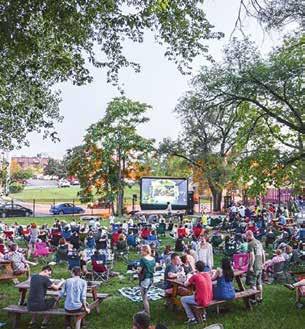
Food, art, music, more art, more food, a family- and kid-friendly atmosphere. And did we already say food and art?
First Fridays is the monthly event in Columbia’s North Village Arts District that showcases that area’s diverse and vibrant art and culture center. A free art crawl on the rst Friday of each month from 6 to 9 p.m. gives visitors access to galleries, shops, and other businesses that are open with music, art demonstrations, children’s activities, food, and more.
More than businesses participate in the end-of-week celebration of Columbia’s creative and artistic talent. Parking is free in the parking garages after 6 p.m.
• Food, drink, and plenty of entertainment are included in the free and open-to-the-public art event.
• First Friday is held in the fastgrowing, vibrant North Village Arts District (NVAD).
• e roughly nine-block-square area, one block north of Broadway, is the perfect t for a walkable, engaging, art- lled experience on First Fridays and every day.
e roar of ATVs and oroad motorcycles combines with the peacefulness of rolling hills at Finger Lakes State Park at 1505 Peabody Road. Built in a former coal-mining area, the park is one of two ATV parks in the state parks system. Finger Lakes’ trails and motocross track are popular with users who come for the day, but they often fall under the spell of the spacious campground, leafy trees, and hilly terrain.
e park is also the site of the challenging 3.8-mile Kelley Branch Mountain Bike Trail and a 4.5-mile water trail.
New last year: e park now o ers a beach wheelchair that visitors with mobility issues can use during normal beach hours.
e spacious campground has 30-amp and 50-amp sites that are reservable. (Before occupying a site, check with the park sta or follow the directions on the posted card or signs.)
• Water to the campground is shut o and the showerhouse is closed during the o -season (November through March). Potable water is available at the park o ce.
• ere are dozens of shing spots for a variety of shing methods and sh species. Grab a park map or just go exploring with rod and reel or an oldfashioned cane pole (and a can of fat nightcrawlers!).
• e park gate closes at 10 p.m. during the on-season (April through October) and 9 p.m. during the o -season (November through March).
Southern Living magazine has called Rocheport, just a short drive west of Columbia, one of the “Best Tiny Towns” in America. e close-knit Missouri River community o ers a variety of activities such as biking and hiking, shopping in quaint stores, staying in cozy bed and breakfasts, experiencing great dining, and enjoying beautiful scenery.
e Missouri Division of Tourism promotes Rocheport as an ideal place for a day trip or weekend stay, with a list of places to play, stay, and eat.
As you check out these selections, you’ll discover plenty more spots to suit anyone’s fancy.
• Sip award-winning wine and tour e Blu top at Rocheport — e Tasting Room, a world-class vineyard in the heart of mid-Missouri.
• Hit the water and reserve a guided oat trip with a naturalist and river historian to paddle down the Missouri River. Take in the picturesque scenery and learn how the river has evolved since Lewis and Clark’s expedition in the 1800s.
• Whether you prefer to walk, run, or pedal, the Katy Trail State Park is renowned among outdoor enthusiasts. As you make your trek through Rocheport, you’ll nd cafes and restaurants, antique shops, and art galleries not far from the trail.
• Places to stay: Mount Nebo Inn; School House Bed and Breakfast; Amber House Bed and Breakfast; Katy Trail Bed and Breakfast.
• Places to eat: Meriwether Cafe and Bike Shop; e General Store; e Bistro at Les Bourgeois Vineyards.

(Re)Discover COMO is a monthly feature sponsored by the Columbia Convention and Visitors Bureau highlighting places, events, and historical connections that new residents and visitors can discover, and not-sonewcomers and long-time residents can ... rediscover.
BY HOSS KOETTING
Ahh, spring! e season of renewal, crocuses, da odils, and Easter. It was a brutal winter, but the sub-zero temperatures are history (at least until next year!). Mother Nature is stirring, grass is growing, birds are singing, and a variety of tasty morsels are sprouting.
Culinary gems, both cultivated and wild, are emerging, if not now, then in the relatively near future.
True harbingers of spring are morels, those bizarre, honeycombed fungi in the woods, and asparagus, in many backyard gardens and truck farmers’ elds. Also cultivated are a wide variety of tender greens — oakleaf, baby romaine, buttercrunch, arugula, and my favorite, black seeded Simpson.

Once you have the desired greens, either home-grown or from one of our great farmers markets, you’ll need to select a dressing for them. at can be as simple as straight vinegar and oil, a simple vinaigrette, hot bacon dressing for a “wilted” salad, or something a bit more substantial. e ubiquitous “Ranch” dressing is more prevalent than ousand Island was fty years ago, and although this is an option, my opinion is that this or any other heavy, mayonnaise-based dressing is going to overpower the delicate texture and avor of the greens.
If you’re not a fan of vinaigrettes, here’s a good compromise that is creamy but also fairly light. It was a popular option at Hoss’s Market’s Harvest Salad, which would go well on an Easter bu et, and it’s also a nice complement to fresh asparagus.

Jim “Hoss” Koetting is a retired restaurateur/chef who enjoys gardening, good food, good bourbon, and good friends.
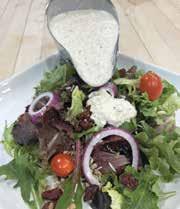
• Your choice of fresh spring greens
• Dried cranberries (Craisins)
• Sliced toasted almonds or sun ower kernels
• inly sliced red onions
• Shredded parmesan cheese
• Tomatoes (Optional, if you can nd some good ripe ones. Cherubs are a good fallback.)
• 1 cup mayonnaise
• 1/3 cup white balsamic vinegar
• Large yellow onion, cut in pieces (enough to yield 1 cup puree)
• 3/8 cup sugar
• 1 Tbsp Dijon mustard
• 1 teaspoon celery seed
• 1 teaspoon salt
• 1/2 teaspoon fresh ground black pepper
• 1/2 tablespoon Hoss’s Italian seasoning
DRESSING DIRECTIONS
1. Puree the onions in a food processor.
2. Mix all remaining ingredients, then mix in the onions.
3. Enjoy!

5 COMO artists serve unique styles to spruce up local eateries.
BY M C KENNA STUMPH
Columbia is host to a vibrant dining scene, and the avors are found on more than just diners’ plates — they are on the walls as well. A diverse array of artists and their unique styles bring movement, color, and conversation to the table.
It’s hardly surprising that as an anchor of the North Village Arts District, Cafe Berlin uses art to accentuate its boho vibe. Adrienne Luther, the restaurant’s manager, features a rotating selection of eclectic art on its walls, some pieces from her personal collection and others by artists interested in selling their art from the restaurant. However, there is one work that’s on permanent display at Cafe Berlin, and it’s by local artist Charlie Bittle — who is all of 10 years old.
Charlie has been drawing since he could pick up a pencil. Holding one of the pieces he keeps at home, he talks about how he makes his drawings.

“I like to start with big stu , like a square, and then ll it in,” he explains. “I never do color. I add a lot of details, so with color it’s kind of hard to tell what the object is.”
After completing a couple of drawings he didn’t want to keep, Bittle asked his mom if he might be able to sell them. She posted them on Facebook on his behalf, and so far he’s made ve sales. Luther was one of those who saw the post, and she immediately jumped on it.
Charlie’s creative streak is more active at night.
“Sometimes I’ll have a sudden idea at school, and I’ll write it down on a piece of paper and take it out at home,” he said, displaying a new drawing. “It took me about eight hours to nish that one.”
e next time you’re sipping an 11 Point IPA at Broadway Brewery, you may spy some pensive, even somber-looking, faces. But they won’t be seated at neighboring tables — they’ll be hanging on the wall, one of the many works by artist Jacky Adelstein that have been featured at the restaurant since 2017.
“I would say that I de nitely tailor the art that’s up there for that wall, which has been sort of an interesting struggle for me,” she said. “My inclination is to put my personality into the art, but there has been a negotiation sometimes where I will make a painting or a drawing and know that I’m not going to show it there because a restaurant has to remain neutral,” Jacky explains.
When she moved back to Columbia in 2016 to be close to her parents, a friend was hanging her art at Broadway Brewery and helped Jacky get in contact with one of the owners. He agreed to let her hang artwork on one of the walls. Adelstein maintains the wall herself, making a new piece for the display anytime one sells.





Randy McDermit’s artwork has been displayed at Tellers since 1999. He came into the restaurant late at night with some friends, and when one of them suggested that he should hang his art there, he contacted the owner. In the past, Tellers rotated the art and artists every month, and Randy exhibited his art for a month at a time. Now his art is the only art hanging on the walls since Tellers recent reopening.
“I like faces and gures, bright colors, and dramatic gestures,” McDermit said. “I’m just interested in human expression. ey’re pretty intuitive, rather than thought out.”
Much of his artwork is sold intermittently throughout the year, with more sales around the holidays.
“I’ve never painted something speci cally for Tellers, but I’ve got enough work that I can kind of look at it and say, ‘Oh, this would hang well.’ I can pick and choose,” he said.




Martin Pope loves the edgy vibe at Sycamore, where he has also been a server. He has sold ve paintings from the restaurant so far this year, and he curates the collection based on his connection to the space.
“ ere’s a punk rock element to this place here, so I wanted to bring some of that energy for my work into this place,” Pope said. “I felt like it would be at home here.”
He currently has more than 150 pieces at his apartment and selects the pieces he hangs at Sycamore starting with the size of the paintings that will t.
“I do see people talk about it all the time, and sometimes I’m their server, and I tell them I’m the painter, and they laugh,” he said. “ ey think I’m joking. en later, they realize that I really did paint it.”
It was on Cindy Scott’s professional bucket list to paint for a restaurant, so when the owner of Casa Maria’s asked her to do the mural for the restaurant, Scott didn’t think twice about signing herself up for a month and a half of work.
“I never thought it would be the entire restaurant, the bathroom, and the kitchen,” Scott said. “It was just one of those things I thought would be cool, just to do art on a huge scale in a public setting. It would be a little feather in my hat, professionally.”
e mural is meant to immerse the customers into Mexican culture, while also modernizing the restaurant. While scaling the walls, Scott was also able to sample food on the menu, which she credits for some of her artistic inspiration.
“I didn’t even call myself an artist until like two or three years into doing what I’m doing,” she said. “I always kept it as it’s something I do. I felt like it was arrogant to call myself an artist. When I just started calling myself an artist, that began to open doors for me. When you step into it and own it, then opportunities come, and people believe in you.”

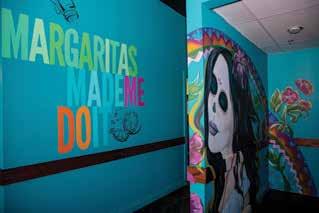
Columbia residents and visitors alike will nd art just about anywhere in the city, whether a bank, city or county government building, o ce waiting rooms, street corners, and building walls — and blending in with the vibe and colors of many restaurants.
If you’re curious about where to look next, just look for a menu and follow your senses.









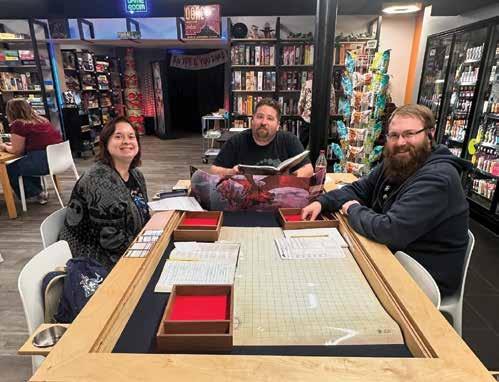
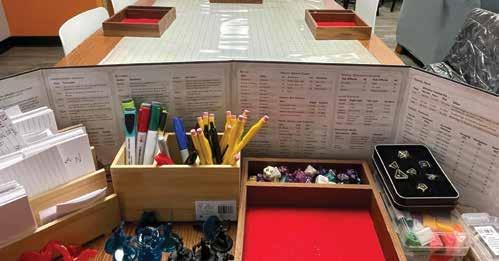
Step into a world where imagination reigns, choices shape destiny, and adventure is only a roll away.
BY KELSEY WINKELJOHN
Aheavy mist clings to the cobbled streets as the midnight bell tolls, its solemn chime swallowed by the dense fog rolling in from the harbor. Somewhere in the distance, a raven caws three times. en silence.
A ickering lantern ahead barely illuminates a hooded gure, motionless except for the rhythmic tap of a silver ring against a wooden sta . Eyes, like embers smoldering in a dying re, peer out from beneath the hood, watching, waiting.
“ e pact you made … it stirs,” the gure says, its voice like the whisper of dry leaves. “And so the game begins.” ese words could come from a mysterious stranger in a fog-shrouded alley or from a Dungeon Master setting the stage for a night of adventure. is is the essence of Dungeons & Dragons, a game where imagination reigns and every choice shapes the journey.
THE GAME THAT STARTED IT ALL
Dungeons & Dragons, commonly known as D&D or DnD, is a tabletop role-playing game (TTRPG) created in 1974 by Gary Gygax and Dave Arneson. Shortly after its release, the fantasy game featuring wizards, warlocks, orcs, and countless other fantastical elements became a nationwide sensation. Now, fty years later, D&D has never been more alive. Across the country — and right here in Columbia — the game continues to bring people together, forging friendships and unforgettable stories.
For local D&D player Christopher Mooney, storytelling wasn’t just a passion — it was a profession. As a lm producer, he was easily drawn to the narrative possibilities of the game after being introduced to Critical Role, an emerging content creator group focused on D&D storytelling, in 2016. Captivated by both the game and its unique approach, he soon saw the potential for his own D&D-inspired content.
“I realized I could do a show because I’m in lm production,” Mooney recalls. “So, I went down that path; there were a lot of logistics involved, and it eventually became a podcast. We got about forty episodes up, and then the attendance kind of zzled through. But that whole experience just got me more into D&D.”
After the podcast concluded, Mooney shifted his focus to sharing and teaching others how to play. Now, every Friday night at Hexagon Alley, he runs one-shot games — self-contained adventures that can be completed within a single three- to four-hour session rather than requiring the long-term commitment of an ongoing campaign.
While it might feel overwhelming to jump into the game as a newcomer, Mooney makes it as simple as possible by providing pre-generated characters (with references to the player’s handbook) and giving players a primer on the game. As the Dungeon Master (DM), he crafts the world and overarching plot, while player choices shape the story’s direction, making it a uniquely collaborative endeavor.
“What’s cool about D&D is that you get to tell a story with other people, and those people get to impact the story,” he says. “So, it’s kind of a mix between theater and improv.”
Friday night attendees are primarily adults, but Mooney will soon expand to hosting part of Hexagon Alley’s “After School Enrichment Program,” working with children ages 8 to 14. He believes D&D goes beyond tabletop fun, teaching kids valuable skills such as teamwork, social interaction, game mechanics, mathematics, and strategic thinking — including critical thinking about moral dilemmas.

e game bene ts adults for the same reasons, especially for those who struggle to interact with others. Mooney describes the D&D community as highly inclusive, especially in his games.
“When we’re here, we’re here to slay dragons,” he adds. “I don’t care who you are. We’re here to explore cool dungeons, nd cool magic items, and just have fun.”
He recommends that new players attend his Friday night one-shots at Hexagon Alley because the environment is safe, public, and inclusive, and he’s a knowledgeable DM who is sensitive to the needs of beginners.
He also emphasizes that games can be as simple or complex as players want them to be — from lming campaigns in costumes with professional cameras, lighting, and music to just sitting around a table with a few friends after a long day of work and blowing o steam in a one-shot. Either way, the game succeeds at bringing people together, whether for a few hours or a couple of months.
e D&D content-creator group Detect Nerd is a testament to the game’s com-
munity-building aspect and encapsulates both its professional and casual sides.
Detect Nerd, created by D&D enthusiasts Elizabeth Keach and Doug Miller, produces live D&D events and online content. However, its origins began in a smaller and more intimate setting.
“ e rst campaign that I was involved in was just a home game,” says Keach. “Just a group of friends that hung out around a table, and there was always a potluck and drinks. at’s where I rst met Doug.”
Keach and Miller developed a strong bond after their characters formed a camaraderie during the campaign. ey soon realized they shared similar play styles and philosophies. With their creative backgrounds in theater and music/ graphic design, respectively, they recognized the potential to take the game from a friend’s table to a polished production. ree years ago, with the assistance of Vidwest Studios, they gained access to professional microphones, cameras, and lighting to enhance their content. And thus, Detect Nerd was born. ey currently have fty-four videos uploaded to YouTube, featuring a mix of story-driven adventures and engaging game sessions.

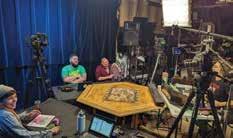
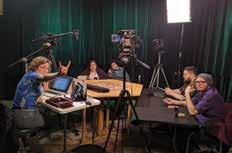
“Detect Nerd welcomes any kind of nerd, whether you’re a plant nerd, or you like cars, and you’re just interested in an entertaining piece of content … I don’t care if you’ve ever played [D&D]. Our main thing is, ‘Do you enjoy what we’re putting out for you? Is it fun? Do you connect or relate to it?’ at’s what our goal is,” says Keach.
Keach and Miller’s goal of making the game accessible to all mirrors D&D’s evolution. Over its fty-year history, D&D has shifted from strict adherence to the handbook to a more exible, player-driven approach, though some groups still prefer the traditional style. Players can now incorporate a number of homebrews — custom content not found in the o cial rulebook, such as unique character classes, races, spells, and settings — into their games.
“ ese [newer] versions of D&D are really built to accommodate di erent kinds of people,” Miller adds. He describes Detect Nerd’s game style as more story-centered than technical, strategic, and dice-oriented, which may make it more approachable to novice gamers.
From hosting live shows to following online creators like Critical Role and Dimension 20, Detect Nerd has noticed a growing trend of “celebrating nerdiness” and fostering a strong community around the game, both virtually and in person.
“When we do live shows and talk to people in the audience, it’s amazing how many people in town are playing,” Miller says. “I think the Dungeon Master’s Guide tells you to ask your players what kind of players they are — whether they’re strategic, storytellers, or just there to make food and hang out. [D&D] really brings together all kinds of people in the community.”
Keach and Miller’s biggest advice for newcomers is to nd a group where they feel comfortable opening up and being themselves. While there’s no right or wrong way to play, di erent players have di erent preferences and styles, so nding a group with a similar approach can make the experience more enjoyable.
ey also emphasize that it’s okay to learn at your own pace — there’s no expectation to grasp everything right away. While the game has many moving parts, at its core, D&D is all about having fun.
Detect Nerd may bring back educational games at some point if it receives requests from interested players; In the meantime, for those eager to start an adventure, there are plenty of places in Columbia to roll the dice. Hexagon Alley, Valhalla’s Gate, and Magelings Games are all welcoming spaces for new and experienced players alike; more information can be found on their websites or social media pages.

Damien is the Assistant Vice President of our Facilities Management Team. Damien is known for his hardworking and positive attitude. He is an advocate for the branches and his work is nothing short of exceptional. His attention to detail and proactive approach have contributed to a better branch experience for both customers and employees!
573-874-8100 • centralbank.net/boonebank







REMODELING & ROOFING



By Austin Hall
Find more at heartlandhomesmo.com
As winter fades and spring brings warmer days, homeowners are eager to spend more time outdoors and refresh their living spaces. It’s also the season when heavy rains can test the durability of a home’s roof. Whether enhancing outdoor spaces or ensuring a home is well-protected from the elements, a little preparation goes a long way.
Bringing the Outdoors In with Sunrooms
Spring is all about enjoying natural light and fresh air, and a sunroom provides the perfect space to do just that. These additions allow homeowners to soak up the sunshine without dealing with unpredictable weather, offering a comfortable retreat for everything from morning coffee to evening relaxation. With designs that blend into a home’s existing architecture, a sunroom can serve as a cozy nook or a spacious extension of the living area. Large windows invite natural light and provide a year-round connection to the outdoors — without the inconvenience of bugs, wind, or sudden spring showers.
Decks and Patios:
As temperatures rise, backyards become an extension of the home. A well-designed deck or patio creates the perfect setting for barbecues, family gatherings, or simply unwinding after a long day. Choosing the right materials and layout ensures not only durability but also a comfortable and inviting space.
From modern patios to rustic wooden decks, a thoughtfully designed outdoor space enhances a home’s aesthetic and functionality. Selecting finishes that withstand Missouri’s changing seasons helps keep these spaces looking great for years to come.
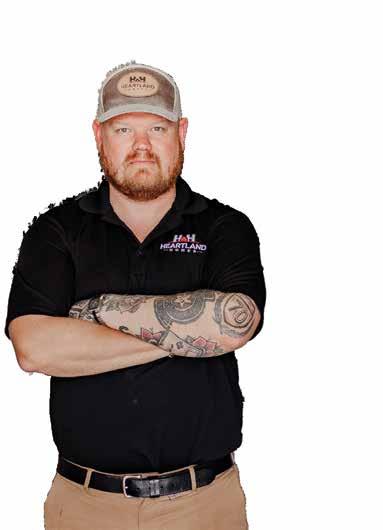
Austin Hall is co-owner, salesman and designer at Heartland. Before starting Heartland, Austin spent eight years perfecting his skills in custom cabinetry and countertop design and installation. Austin has been a board member of Columbia’s Home Builder Association since 2020, he is currently serving as the President and has been either co-chair or chair of the MidMissouri Home Show since 2018. He, his wife Khila and two children, Rylan and Beckett, live in Rocheport and love to relax at the Lake and travel.


Roofing Maintenance: Protecting Against Spring Rains
While spring brings pleasant weather, it also brings heavy rains that can expose weaknesses in a home’s roof. A compromised roof can lead to leaks, water damage, and costly repairs if not addressed early. Regular inspections and maintenance help catch small issues before they become big problems.
Checking for damaged or missing shingles, weak flashing, and signs of leaks is essential for keeping a home protected. Clean gutters also play a crucial role in preventing water buildup, which can lead to roof damage or even foundation issues. A little preventative maintenance can save
homeowners from major headaches down the road.
Spring is the time to refresh and renew, not just in nature but also at home. Whether adding a sunroom for more natural light, creating an inviting outdoor retreat, or ensuring the roof is ready for spring, tackling these projects now will make for a more enjoyable and worry-free season.
Heartland Homes specializes in sunroom additions, decks, patios, and roofing maintenance. With expert craftsmanship and quality service, we help homeowners make the most of spring. Contact us for a quote today.
By Mike Messer MMesser@ShelterInsurance.com
Have you ever heard the term “inland marine insurance”? Perhaps it has even been mentioned a few times and you were too embarrassed to ask what it was –or maybe you just thought “Why would I need that? I don’t own a boat.”
No worries, we’ll help clear up the confusion. The term “inland marine insurance” dates back to the days when companies shipped large quantities of goods by wagon or steam ship. Owners needed insurance coverage for the risks those items faced along the way. Now, inland marine insurance is commonly referred to as personal articles insurance. This type of policy is designed to protect hard-to-replace valuable items, especially valuable collections or jewelry.
These are just a few of the most common types of items our policy helps to cover:
• Antiques
• Fine Art
• Furs
• Coins
• Silverware
• Stamps
• Guns
• Jewelry
• Musical instruments

• Photography Equipment
• Golf Equipment
• Bicycles
• Small Portable Power Tools
• Contractors Equipment
• Lawn tractors and mowers
Doesn’t My Homeowners Insurance Policy Cover My Valuable Personal Property? It does, but homeowners policies have coverage limits. For example, if you have a diamond engagement ring, it might be covered for theft under your home insurance coverage (subject to your policy limits and exclusions); however, if the diamond falls out of the setting and is lost, it’s likely that only a personal articles policy would provide enough coverage to help you replace the stone. This distinctive coverage was intended specifically for the more valuable items you own that may be exposed to a larger variety of risks and threats. Typically, a personal articles policy has lower deductibles and higher coverage limits, your items are covered by more perils and making a claim will not trigger a service charge.
That depends on what you want covered. It’s important to keep receipts and/or appraisals for anything you want covered. In addition,
With over two decades in the insurance industry, Mike Messer has served as a claims adjuster, supervisor, and underwriter, giving him a well-rounded understanding of how policies work when it matters most — before and after a loss. He prioritizes building relationships based on trust and personalized service, recognizing that every client’s needs are unique. Through annual policy reviews, he helps ensure clients stay informed, confident, and properly covered, providing them with peace of mind and financial security.
AIC, LUTCFSHELTER INSURANCE ® ®

make an inventory list and take pictures of each item. To help, you can use the Personal Property Calculator on our website.
If you are interested in learning more about a personal articles policy or getting a quote for your most prized possessions, contact Mike Messer – you may be surprised by the price of this extensive coverage!
Note: All coverage is subject to your policy provisions. Some types of property are not covered at all, and some types of losses are not covered. The policy purchased and the facts of each claim will control coverage. This article may not show all coverages that are available, or it may show discontinued coverages. In the event of a conflict between the policy purchased and this article, the policy’s provisions will prevail.
By Kelly McBride
Find more at rostlandscaping.com
M
om, Mama, Mommy. Nana, Gigi, Grandma. No matter what you call them, mothers (and grandmothers) are heroes in so many of our lives, and their jobs are never done. Mother’s Day will be here before you know it, and whether your mom is a gardener or not, there are so many gift options that will make a huge impact and show your mom the love she deserves. Here’s a quick guide to some nofail gifts to make this Mother’s Day special.

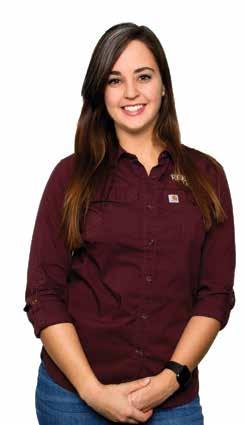
This is a classic for a couple of reasons. One-they are ready just in time for Mother’s Day, so they are full and beautiful right off the bat. Hanging baskets provide five months of color so it lasts so much longer than a bouquet will. Two-there are so many color and plant combinations, as well as options for shade and sun, you get to pick out something that she will love!

Not sure what your mom wants for her landscape or garden? There is nothing wrong with a gift card. She may want a new tree for the front yard, or she may want some veggies and herbs for her summer garden. You can give her the freedom to pick whatever she wants! Our tip? With the gift card, say you’ll come shopping with her and maybe grab lunch after so it’s more than an easy gift, it is time spent together.

The great thing about this gift is that you can go in 2 different directions. If your mom enjoys working outside or with plants, a gorgeous piece of pottery will allow her to pick out plants to decorate her front porch or patio each season. If not, our staff can help you select a mix of plants and go ahead and plant it for you so it’s ready to go on Mother’s Day and she can just enjoy it.
Kelly McBride grew up in Columbia just down the road from Rost Inc., and she's happy to still call Columbia home. She has a degree in plant science and landscape design from MU and was hired as Rost’s landscape maintenance manager after graduation. Her love for plants makes this job very enjoyable when assisting clients with their outdoor tasks. Outside of work, you can find her cooking, gardening, sewing, or doing other outdoor activities.

There’s something about a lilac, specifically a fragrant variety, that is so nostalgic for so many people. That’s why a Lilac is such a beloved Mother’s Day gift. There are many varieties to choose from such as this Dwarf Korean Lilac that has classic purple blooms and the familiar scent and will reach about 4’ tall x 5’ wide.

If you’re thinking about flowers, a peony should be top of mind. Their big, beautiful blooms are so pretty in the landscape and perfect for cutting and putting in vases too. There’s a vast array of colors and types to choose from but consider checking out the Itoh Peony family for its sturdy stems that uphold its large blooms, or the new Patio Peony series bred to be more compact with fabulously fragrant blooms.

An ornamental tree is a such a special gift because it is literally the gift that keeps on giving. Whether you select something big or small and no matter what color, each spring when it blooms, it’ll remind her of all the love she was shown on this Mother’s Day. We can help you find the perfect flowering tree for your mom but consider this April Showers Crabapple with its elegant weeping branches and fragrant blooms.
By Jeremy McKenzie tintbytoalsonllc@gmail.com
The U.S. Fish & Wildlife Service estimates that between 600 million and 1 billion birds die each year in the United States due to collisions with windows. These collisions often happen because birds mistake reflections of the sky or surrounding greenery in glass for the real thing. This problem is especially common in urban areas, where large glass buildings create a hazardous environment for migratory birds.
One effective solution to reduce these accidents is the use of specialized window film that enhances visibility for birds, making glass more apparent to them. These films come in various textures and patterns, such as dots, stripes, or UV coatings, which help break up the reflections that lead to collisions. Many of these films are designed to be nearly invisible to humans while significantly improving bird safety. When installed professionally, they blend into a building’s design and provide life-saving protection for birds.
The positive impact of bird-safe glass solutions is evident in major cities. One example is the McCormick Place Convention Center in Chicago, which made national news after nearly 1,000 birds collided with the building in a single day. In response to this, the convention center installed specialized bird film, which resulted in an almost 90% reduction in collision fatalities. Inspired by such success stories, cities across the U.S. have begun implementing birdsafe building regulations, requiring new constructions and major renovations to include bird-friendly glass treatments.

Jeremy is a Columbia native who has lived many different places including abroad until finally making his way back home and purchasing Tint by Toalson in 2016. We continue with the small familyowned business mindset that made Toalson such a well-known name in the Columbia community and always provide completely free estimates.

(573) 443-8468
Tintbytoalsonllc@gmail.com
Homeowners and small business owners can also take these simple yet effective steps to protect local bird populations. If you notice a high number of bird collisions at your home or workplace, installing bird-safe window film can make a significant difference. Protecting birds from window strikes is becoming increasingly important, and
with the proper measures in place, we can all contribute to a safer environment for our feathered neighbors.
If you have noticed a high number of collisions at your home or business, Tint by Toalson may be able to help. Visit our website for more information about the services we offer and schedule a free consultation.


As traditions go, this one has its own niche and attractions.
BY SUNITHA BOSECKER



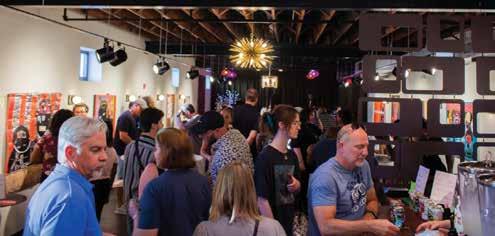

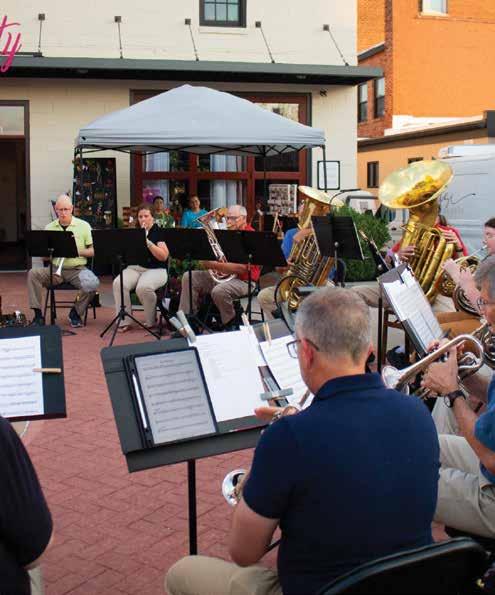


As the sun sets on the rst Friday of every month, the North Village Arts District transforms into a spirited center for all things art in downtown Columbia. But First Fridays is more than just an art walk. It’s an immersive experience where live music, artisan cuisine, and local talent come together to showcase the city’s thriving creative scene. From niche bakeries to inspiring galleries, the monthly event has become a beloved tradition for newcomers and longtime patrons.
Step into the heart of First Fridays, and you’re immediately enveloped in an atmosphere of artistic energy. Music spills from gallery patios, the scent of fresh pastries and savory dishes wafts through the air, and each storefront features new attractions to discover. Whether you’re indulging in a handmade chocolate covered cheesecake tru e from Wish our Bakery or watching a painter bring a canvas to life, the event engages all ve senses in a way that feels both exhilarating and personal.
For Marcey Mertens, owner of Wish our Bakery, the event is a whirlwind of excitement.
“We started getting involved in May 2022,” she explained. “Now, we have a line out the door for three hours — people grabbing dinner and sweets, just having fun.”
Each month, Mertens and her team craft a special menu based on seasonal ingredients, trending avors, and sheer inspiration.
Her advice for rst-time attendees? “Come early.”
Across the way at Serendipity Gallery, Elizabeth Jordheim has been curating the First Fridays experience since August 2020.
“Our art exhibits are scheduled far in advance — sometimes one to two years ahead,” she noted. “We book musicians early, add pop-up food vendors, bring in guest artists, and even have wellness providers from Serendipity Wellness Studios o ering interactive experiences.”
Jordheim describes First Fridays as “energetic, lively, uplifting, and culturally rich — a time for connection.” e gallery’s ever-evolving lineup ensures there’s always something new to experience, from live performances to surprise exhibitions.
“You can feel the energy shift as people explore, talk with artists, and get swept up in the atmosphere,” she said. One bonus: enjoy a glass of wine while you explore the intimate gallery.

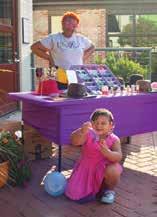
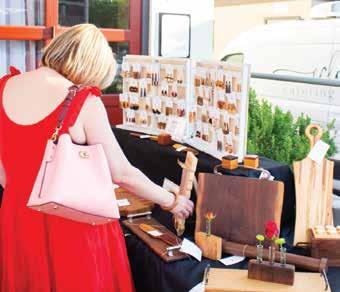
Beyond the food and the music, First Fridays is about fostering a sense of belonging. e event thrives because of the artists, business owners, and community members who dedicate themselves to make it special.
Nikki Reese, events and business coordinator for the downtown Community Improvement District and marketing coordinator for the North Village Arts District, plays a key role in promoting the event.
“ e First Friday Free Art Crawl is an immersive celebration that engages all your senses,” she said. “You can have conversations with seasoned artists, unique handmade crafts from assortment of vendors, and indulge in everything from pasta to pastries.”
For Reese, one of the most impressive aspects of First Fridays is its nancial accessibility.
“ e crawl itself is absolutely free, so you can take your time exploring galleries and performances without any pressure,” she added. And don’t worry about parking — it’s free for the rst hour, and after 6 p.m., it’s free in all downtown garages.
First Fridays isn’t just for seasoned art lovers — it’s an open invitation for anyone curious about Columbia’s creative scene.
Christina McGuckin, a regular attendee, recalls her rst experience: “I got involved through friends about ve years ago. I had lived in Columbia for a while but had never heard of First Fridays until they invited me. I went for the social aspect and kept coming back for the experience.”
For McGuckin, the magic of First Fridays lies in its inclusivity.
“It brings out people of all types that color the one-of-a-kind canvas that is the Columbia community,” she says. “It’s a nice walk through the North Village Art District and there is live music to enjoy, free drinks, demonstrations, and pieces to purchase along the way. ere is never a dull moment.”
If you’re planning your rst First Fridays outing, local experts have some advice to help you make the most of the night:
• Arrive Early, Stay Late: Many businesses, like Wish our Bakery, see long lines early in the evening. Arriving early gives you a chance to grab a treat before the rush, while staying late lets you soak in every last bit of the event’s magic.
• Support Local Artists and Businesses: “First Fridays can only continue if the businesses thrive,” Jordheim advises. “Buy dinner, enjoy a drink, purchase original art, and tip the musicians and bartenders.”
• Engage with the Artists: Reese encourages attendees to talk to the creators behind the work, adding, “ ey are the reason First Fridays happens. Hearing their stories adds so much to the experience.”
• Explore Beyond Your Usual Stops: McGuckin recommends wandering into every gallery and shop, even if you’ve been before. “Each one speaks to di erent people in di erent ways,” she noted. “Find what resonates with you.”
• Bring the Whole Family: First Fridays is a family-friendly event, with activities designed to engage kids as well as adults. From hands-on art stations to live entertainment, there’s something for everyone.
ere’s plenty in store for First Fridays regulars and newcomers alike in 2025. While businesses keep their plans under wraps, a few enticing details have already emerged.
Serendipity Gallery plans to bring its wellness and beauty providers into the event more regularly, o ering interactive experiences that blend art with self-care. And, of course, the highly anticipated Annual Roof Party for the North Village Arts District will return, bene ting the arts district and ensuring that First Fridays continues to ourish.
Each month, attendees can expect new exhibitions, surprise performances, and an ever-changing lineup of food vendors and musicians. Whether it’s your rst visit or your ftieth, there’s always something fresh to discover.

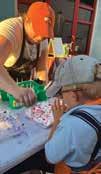
As Columbia’s creative heartbeat, First Fridays is more than just a night out — it’s a tradition that brings people together through art, music, and shared experiences. It’s a space where local talent shines, where friendships are formed over a shared love of creativity, and where the city’s cultural identity is celebrated month after month.
Arrive hungry, bring your curiosity, and prepare to be inspired.
For updates and sneak peeks at what’s coming next, follow the North Village Arts District, Serendipity Gallery, and Wish our Bakery on social media. ere are many other small businesses and vendors to discover in the North Village Arts District during traditional business hours as well. All photos on page by
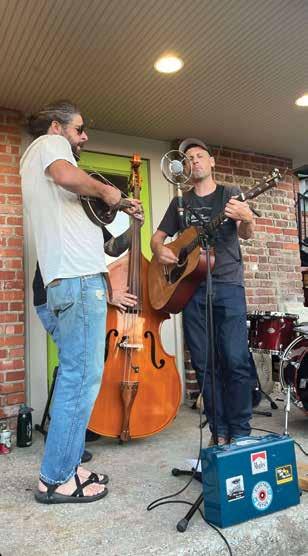
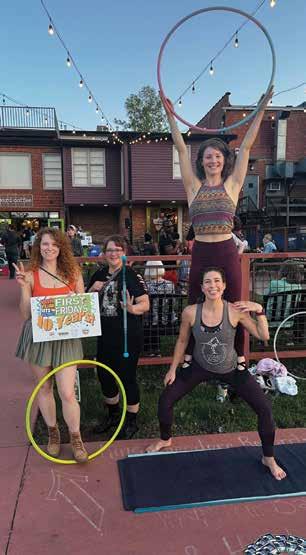

The digital future of Columbia’s historical records.
BY MADELEINE LEROUX
FFor more than two centuries, Columbia’s history has been documented in photographs, newspapers, and legal records. But paper and lm don’t last forever. Across Boone County, organizations are working to ensure that the past is not only preserved, but also made more accessible than ever through digitization.
It’s a painstaking process, requiring careful scanning, entering of metadata (detailed information such as dates, locations, and subject descriptions), and deciphering of handwritten records. At institutions like Daniel Boone Regional Library (DBRL), the State Historical Society of Missouri (SHSMO), the Boone County Recorder of Deeds O ce, and Boone County History & Culture Center, the e ort is well underway.
“ e records tell the story of how Columbia and Boone County came to be,” said Bob Nolte, Boone County recorder of deeds. “How we were settled, how we've grown. We’re making that history more accessible, piece by piece.”
DBRL began its digitization projects nearly a decade ago, transforming historical documents into a searchable online archive. Seth Smith, a librarian involved in the project, said the library has digitized 100 years of yearbooks, rare photographs, and unique publications, such as the Trouble with Normal , an underground music zine from the 1990s and 2000s.
“Zines were important ways, maybe like blogs are now, for voices that weren’t always heard,” Smith said. “It’s a snapshot of the local music scene and cultural commentary that otherwise might have been lost.”
Other notable collections include the Midway One Room Schoolhouse Collection and the Southern Boone County Collection, which document rural education and small-town life in Mid-Missouri.
While the library once relied on volunteers, sta members now handle most digitization work, using opensource software to catalog and store materials online. Future projects aim to digitize more local publications and ex-
pand the archive with additional community contributions.
DBRL is also exploring ways to enhance searchability by incorporating AI-powered optical character recognition technology, making handwritten documents easier to read and analyze.
Few records o er a clearer glimpse into history than newspapers. Since 2008, SHSMO has led e orts to digitize Missouri newspapers, starting with grant funding from the National Endowment for the Humanities and the Library of Congress.
“We have over 8.5 million Missouri newspaper pages digitized, with coverage spanning from 1808 to 2020,” said Katie Ziegler of SHSMO. “It’s a massive undertaking, but it’s essential for accessibility and preservation.”
e process involves scanning old micro lm and making the pages searchable through keyword indexing. SHSMO partners with Newspapers.com to digitize select newspapers, which are initially available through the site’s subscription service. After a three-year embargo period, these newspapers become freely accessible through the Missouri Digital Newspaper Project.
e demand for digitization is high, particularly among genealogists who rely on society pages and local news to trace family histories.
“Digitizing newspapers is critical because these pages hold the rst drafts of history,” Ziegler said. “Scanning micro lm and making the pages searchable through keyword indexing ensures that researchers and the public can nd information that may otherwise have been lost.”
At Ellis Library on the University of Missouri campus, this digital accessibility recently contributed to a Black History Month exhibit featuring Spencer T. Banks, a commercial artist and one of the rst Black cartoonists to create a nationally published strip featuring a Black female protagonist. Research for the display relied heavily on digitized archives, demonstrating how these resources continue to shape historical understanding.
Beyond newspapers, SHSMO continues to digitize archival records, manuscripts, and photographs. Heather Richmond, a historian with SHSMO, said these types of documents help show life beyond what would have been considered newsworthy.
“ e breadth of our collections means we’re preserving not just well-known historical events, but also the everyday lives of Missourians,” Richmond said. “Whether it’s a store ledger from the 19th century or letters exchanged between neighbors during wartime, these materials help tell the full story of our state.”
SHSMO’s e orts include maintaining micro lm backups to ensure future generations have both physical and digital access to historical documents, safeguarding against potential technical issues in the future.
One of its most signi cant projects involves transcribing Civil War letters, which provide rsthand accounts of battles, personal re ections, and insight into the daily lives of Missourians during the war.
“ ese letters are more than just historical documents — they’re voices from the past, giving us un ltered glimpses into the emotions and experiences of people who lived through an incredibly turbulent time in our nation’s history,” Richmond said.
Another major addition to SHSMO’s digital archives is the recently discovered diaries of Sara Lockwood Williams, an in uential journalist and editor. Williams’ writings from the late 1800s to early 1900s shaped public discourse and provided a rare rsthand perspective on women in the newsroom. As one of Missouri’s early women journalists, her documentation of societal expectations and historical events — as well as the challenges of being a woman in media — o ers an unparalleled glimpse into the period. Her diaries, lled with vivid details, are being carefully transcribed and digitized to preserve her voice and contributions to journalism for future generations.
“Her diaries o er an unparalleled glimpse into the struggles and triumphs of women in journalism during that era,” Richmond said. “ ey re ect not only her personal experiences, but also broader changes in the eld.”
Interested in contributing to these digitization efforts? Several organizations offer ways for community members to get involved:
Daniel Boone Regional Library welcomes contributions of historical materials, such as yearbooks, photographs, and local publications, to expand its collection. If you have items that could add to the archive, contact the library at archive@dbrl.org for guidance.
State Historical Society of Missouri relies on volunteers to help transcribe handwritten records — including Civil War letters and Sara Lockwood Williams’ diaries — into searchable text. These efforts make fragile documents accessible to researchers and the public. Learn more by visiting shsmo. org/support/volunteer.
Boone County History & Culture Center seeks volunteers to assist with scanning historical photographs and documents, as well as creating metadata to properly catalog materials for digital preservation. To get involved, contact Brian Flanagin at BrianFlanagin@BooneHistory.org.
By supporting these efforts, Columbia residents help ensure that the city’s history remains accessible for generations to come. As Ziegler of SHSMO said, preserving history starts with community support — subscribing to your local newspaper contributes to the vital record that future historians will rely on.
Additionally, SHSMO researchers are working to cross-reference Williams’ work with existing newspaper archives to uncover previously unknown pieces she may have written under pseudonyms.
At the Boone County Recorder of Deeds o ce, digitization has been revolutionizing for historical land records. Boone County Recorder Bob Nolte said deed records dating back to 1821 are available online, with an indexing project extending back to 1965.
“ e records tell the story of how Columbia and Boone County came to be,” Nolte said. “We can see the original town layout, early surveys, and how the land was divided and developed.”
Digitizing handwritten records remains a challenge, particularly as the project moves further back in time. Some documents require high-resolution rescans to improve readability. In addition, older deed of trust books, which track property mortgages, have yet to be digitized due to funding constraints. Nolte said the older deeds are less likely to be needed for current real estate transactions, and he has to be mindful of the most e cient use of his funding.
“ ere’s a balance of being a good steward of taxpayer funds and trying to get as much of this information digitized and available to the public, while also recognizing what is most important for our end users,” he said.
Photographic archives provide a unique window into Columbia’s past, and preserving these fragile materials is a complex process. Brian Flanagin, lab manager at the Boone County History & Culture Center, leads e orts to digitize a plethora of community photographs, from old college yearbooks to negatives from local photographers like Paul Parsons, whose work dates back to the 1930s.
“ ese negatives are delicate, and some have to be responsibly destroyed after digitization,” Flanagin said. “We use specialized equipment to scan and invert the images, ensuring they’re preserved even if the originals deteriorate.”
Digitizing early negatives is meticulous work, requiring careful handling to prevent damage. Flanagin’s team members use an Italian-made scanner that captures high-resolution images before converting them into positive prints. ey then apply digital restoration techniques to correct exposure issues, enhance contrast, and repair minor imperfections caused by age and environmental factors. e team also focuses on metadata — the detailed descriptions accompanying each image — to help researchers understand the context of historical photographs.
Flanagin noted that long before Photoshop existed, photographers had their own methods of image enhancement.
“ ere are negatives where you can see hand-painted touch-ups, shading to soften facial features, or even details added in after the fact. It’s early retouching,” he said. ese methods re ect the artistry and skill involved in early photography, as well as the desire to create the most attering portraits possible.
“Fashion trends, town developments, and even everyday life are all captured in these images,” Flanagin said. “We’re seeing the introduction of rib-knit sweaters and pearl necklaces in the 1930s, along with changing hairstyles and the emergence of new fabrics. It’s a fascinating look at how culture evolved.”
e Boone County History & Culture Center is also collaborating with local institutions to share its digital archives more widely. As new photographic collections surface, the center hopes to expand its catalog, preserving even more visual history of Columbia. A future initiative may include 3D imaging techniques to digitally reconstruct damaged or lost photographs, providing new ways for researchers to study and analyze historical images.

High winds, heavy rain, and hail can take a toll on your home. Protect what matters most with impact-resistant shingles and storm-ready windows and doors—installed by the experts at Manor Roofing & Restoration.





BY NATASHA MYRICK
Across cultures and generations, music often plays a fundamental role in shaping who we are as people. Whether it is a part of our traditions or used to commemorate certain events, music carries deep signi cance.
at’s especially true for the life-changing — and life-giving — experience of childbirth.
“Music and birth just make sense,” says Anna Page, a Columbia doula whose own traumatic birth experience led her on a journey of healing that she now helps others travel.
“Music is a universal language — it goes beyond time periods, generations, languages,” Page explains. “ ere is something very primal about music, even if it is modern music. It speaks to the soul.”
It’s a conclusion that former Miss Missouri Shelby Ringdahl shares. Ringdahl, Miss Missouri 2013, said that she felt music was already connecting her with her son when he was in the womb.
“Music really connected Hudson and me from the get-go,” she said. During pregnancy as a performer, Ringdahl’s main job was growing a baby, but it was important for her to feel like she could still ful ll her professional aspirations. While pregnant, she performed in multiple shows; one in Columbia with the Missouri Symphony, and a solo cabaret show in St. Louis that was sold out.
At the end of the show, she said she could feel Hudson start kicking. She also co-directed and performed in “Merry ‘Ol Missouri” at the Missouri eater. Pulling o that show as a pregnant woman was no small feat.
“To be able to be growing a human while singing with a symphony on stage, running around in my heels, dancing, changing costumes,” she continued, “it was empowering to be like, ‘Look, I can be a mom and do what I love to do.’”
Dr. Brittany Fatoma of the Mid-Mo Black Doula Collective credits her daughter’s love for music to how much singing and listening to music she and her husband did when her daughter was in utero. Dr. Fatoma became a doula after as the result of a traumatic birthing experience where she ended up almost dying due to preeclampsia during postpartum.
“I didn’t want anyone to have the lived experience that I did,” she said. Dr. Fatoma has four degrees: EDS degree in admin and leadership, EDD doctorate of educational leadership and policy analysis, and Bachelor’s of Science in elementary education. She believes her education and degrees pair so well with being a doula because she can meet and engage with parents before they have their child as “embracing your role as your child’s rst teacher.”
Welcome to the vibrant world of Platinum Paws, where pets become walking works of art.
BY KELSEY WINKELJOHN


Imagine this: It’s a perfect day in Columbia. You’re out for a casual afternoon stroll, soaking in the sunshine and breeze, when something catches your eye. You do a double take. Is that … a red panda? On a leash? You step closer, half-expecting to see an exotic animal up close and personal — only to realize it’s a bright orange Chihuahua.
FROM THE BEGINNING
A pink poodle or a husky with a galaxy-inspired coat might sound like something out of a dream or a cartoon, but for pet owners and groomers who embrace creative dog dyeing, it’s a bold and playful form of self-expression.
Melodi Wisswell, owner of Platinum Paws, has more than a decade of experience in the dog grooming industry. She began her career at PetSmart in 2014, where she was rst introduced to creative grooming, which encompasses various techniques, including coloring, shaving shapes into fur, and adding accessories.
“For a while, they [PetSmart] o ered stencil work and chalking, which really got me interested in creative grooming,” says Wisswell. “And then they stopped o ering it. I guess it just wasn’t pro table across the board.”
Wisswell began grooming animals independently and, after a brief return to PetSmart, opened her grooming salon on West Broadway in May 2023. ere, she continued to o er traditional services like baths, brushing, and de-shedding. However, her passion for creative grooming never faded, and she sought ways to incorporate it into her new business.
When she adopted her Bernedoodle, Bellatrix, a year ago, she found the perfect canvas for her artistry. One of her most striking designs showcases a blend of purples, blues, and teals, with wings spanning Bellatrix’s back, matching leg accents, and vibrant ears, creating a near-mythical e ect. She jokes that Bellatrix is “a walking billboard” for her work, drawing plenty of attention and sparking curiosity about her unique craft within the community.
Scan the QR code to explore the powerful connection between music and the birth experience, from pregnancy to delivery.
Scan the QR code to learn how Melodi Wisswell brings colorful transformations to pets — and more pictures, of course!
e Columbia Art League and the Museum of Art and Archaeology. Favorite artist is Kate Gray.
– JERRY PRICE
Any of Michael Wolf’s paintings at Logboat!
– GARY MICHAEL LEE
Martin Pope.
– DIANA RATLIFF
e bronze “Jamboree” sculpture of animal instrumentalists on the Boone County Courthouse Square. My all-time fave!
– LIZ BURKS
Shannon Webster.
– TIFFANY SANFORD
I found Michael Steddum at Art in the Park last summer and fell in love with his artwork!
– GABRIELLA JAUCH
I think my favorite art in COMO is the butterly wings by Madeleine LeMieux! It’s such a cute little stop in the middle of downtown you wouldn’t expect!
– ASHLEY LASITER
It’s simple but I love the butter y mural on Alley A, just a fun photo op and adds some color and makes the alley more welcoming right from the start.
– SARAH JANE SHORTHOSE
I’m a fan of Art Chica Marcum. We have several of her items around the house.
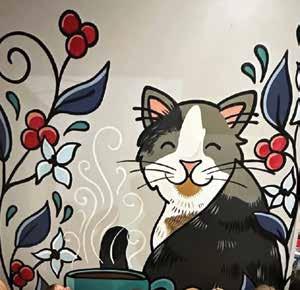
My favorite art is the scary bunny with yellow eyes on the left wall high above the ‘fridge at Sparky’s Homemade Ice Cream. e painting shows a scary white bunny standing next to a dude. Bunny is wearing a suit and a bolero.
– CASEY BARWICK
I guess I’ll have to chime in here since no one has yet suggested the one art installation that everyone still talks about more than twenty years after gracing Columbia’s landscape: Cypher. at’s the o cial name of the pair of steel structures that seemingly guard the entrances at Columbia Regional Library at the northwest corner of Garth and Broadway. ey are the work of sculptor Albert Paley and were installed in 2002. Various publications have noted that the unmistakable steel structure has been interpreted as the pages of a book ipping open, something that fell from Skylab, or — and let’s say it together — ying french fries.
– JODIE JACKSON JR
David Spear is one of my favorite local artists!
– ROBIN MORRISON
– KATHRYN DETERS
I just love Adrienne Luther. While I am particularly biased, the work she did for our mural at Bertha’s Beans makes me smile!
– JESSICA JENSEN SCHLOSSER
Anything Adrienne Luther!
– DAVID HALL KAYCEE
Check out e Montminy Gallery!! (At the Boone County History and Culture Center.)
– ANGELA LECHTENBERG
Jenny McGee! She is such a steady force, promoting creativity and healing love.
– TONI RAHMAN
John Mueller Design + Art. Jon has designed the Mizzou Homecoming logo for the last several years. His watercolors and Mizzou pieces are absolutely gorgeous!
– ERIKA PRYOR
Do so m e t h i n g
